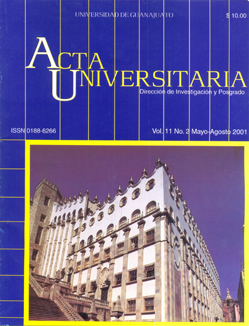CARACTERIZACIÓN MOLECULAR DE AISLADOS DE Sclerotium cepivorum MEDIANTE ANÁLISIS DEL POLIMORFISMO DE LOS FRAGMENTOS AMPLIFICADOS AL AZAR
Publicado 2001-08-01
Palabras clave
- White rot,
- Sclerotium cepivorum,
- RAPD,
- genetic variability,
- garlic disease.
- Pudrición blanca,
- Sclerotium cepivorum,
- RAPD,
- variabilidad genética,
- enfermedades del ajo.
Cómo citar
Resumen
Sclerotium cepivorum es el agente causal de la "pudrición blanca" del ajo. El conocer su variabilidad genética permitirá buscar estrategias de control mas eficientes. Se utilizaron 47 aislados de S. cepivorum provenientes de Aguascalientes, Guanajuato, Zacatecas y 7 cepas de referencia. El análisis morfológico correspondió al establecido para este hongo. Se amplificó el gen ribosomal 18S dando un tamaño cercano a 2.2 kb en todos los aislados y cepas de S. cepivorum, en los hongos control fue de aproximadamente 18 kb. El grado de variabilidad se analizó por medio del Polimorfismo de los Fragmentos Amplificados al Azar (RAPD). Los aislados de S. cepivorum dieron un patrón génico similar, pero muy diferente al que muestran los otros hongos fitopatógenos. La disimilitud genética promedio fue de 9.4%. Se proponen algunas bandas como marcadores moleculares para identificar al fitopatógeno. En el dendograma se aprecia que hay tendencia de los aislados a agruparse según el estado de donde provienen.

